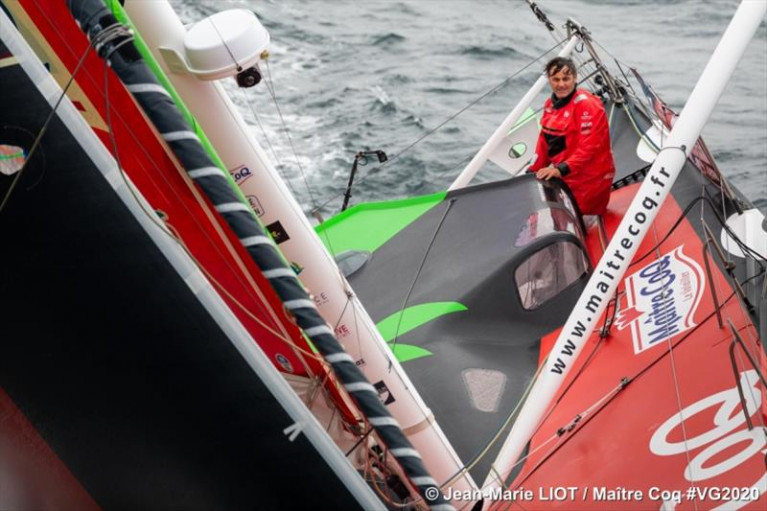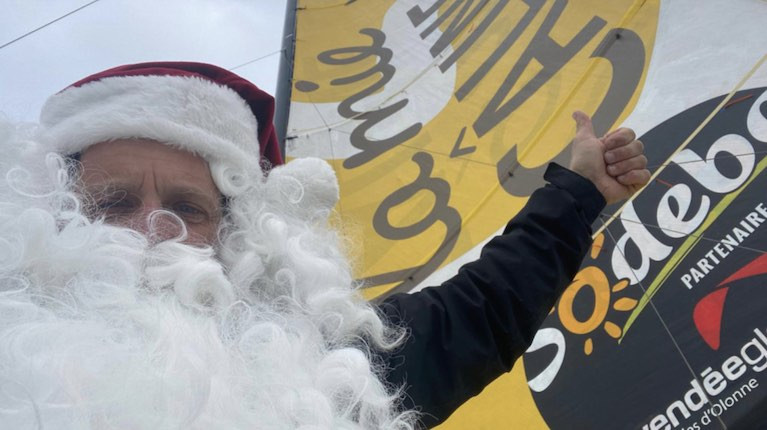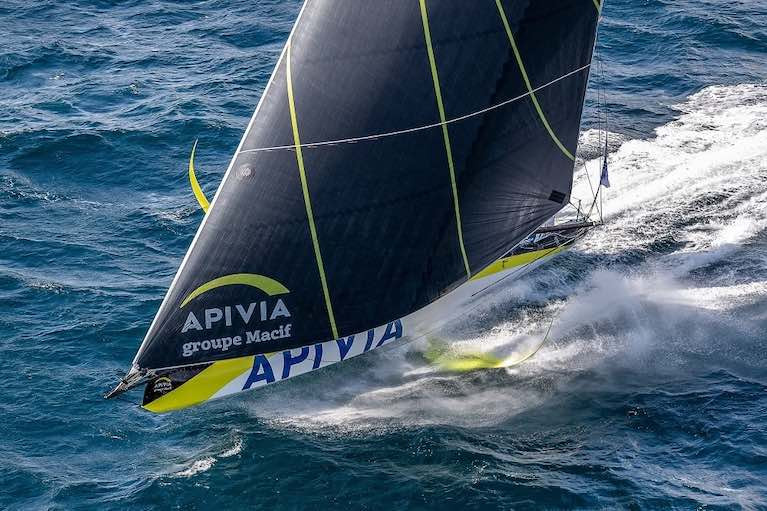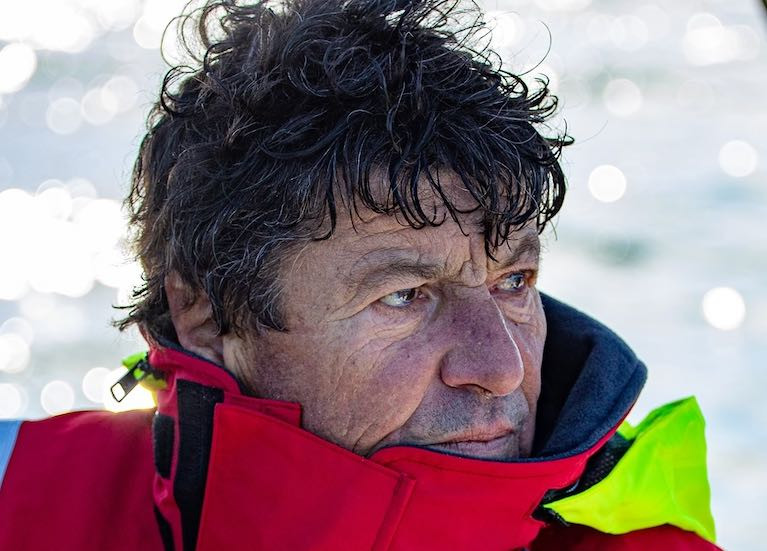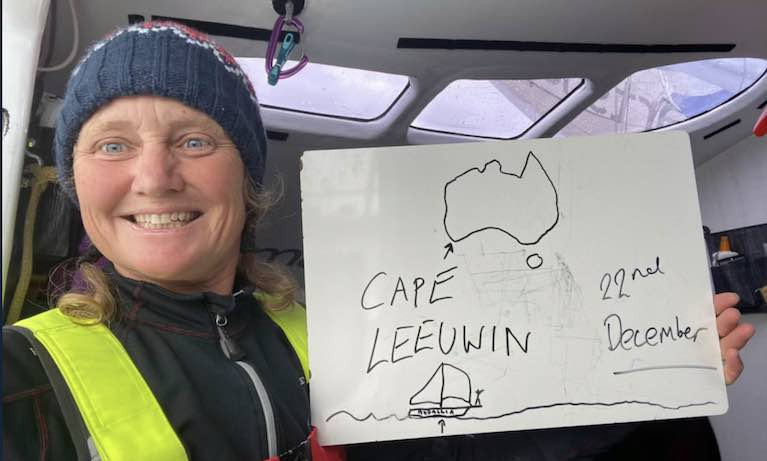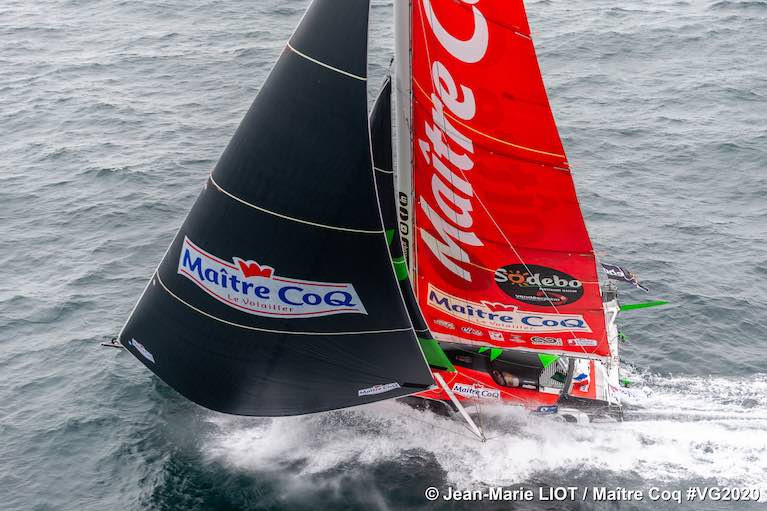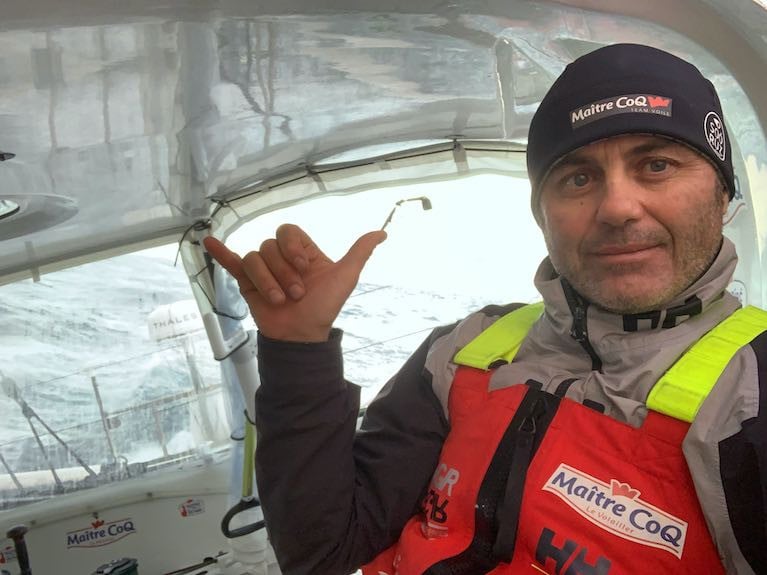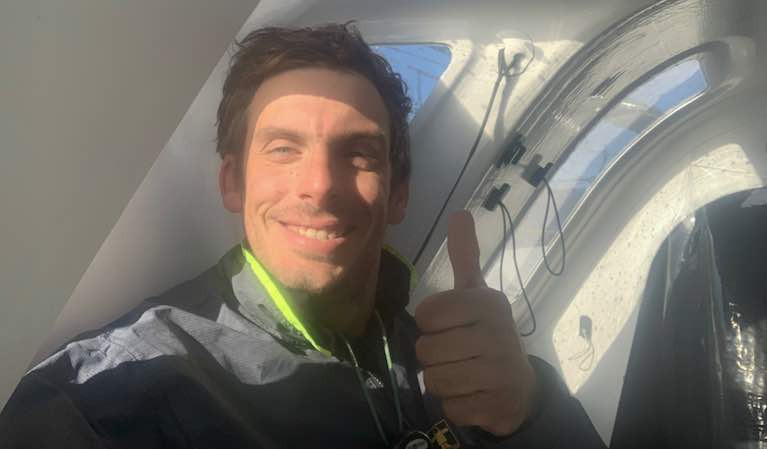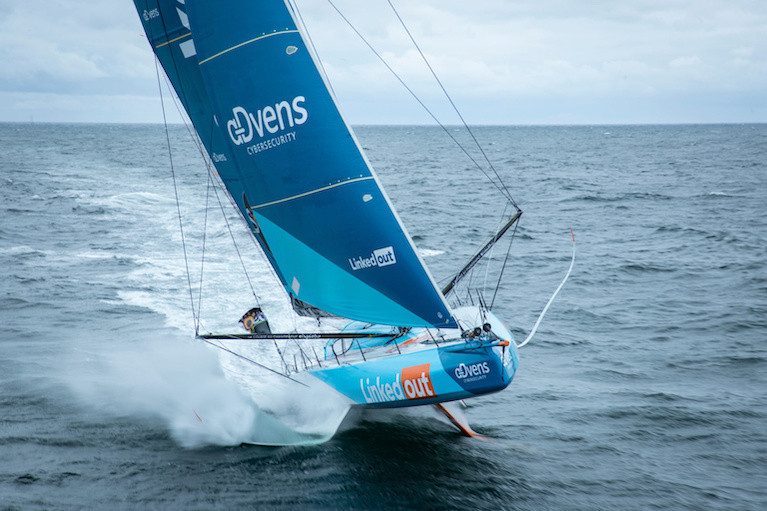Displaying items by tag: Vendee Globe
Yannick Bestaven Back in the Lead of the Vendee Globe Race
Still racing upwind but having changed on to the ‘making’ port tack – the angle taking them closer to the mark than away from it – Yannick Bestaven (Maître Coq) is back in the lead of the Vendee Globe race but only by a small handful of miles over Charlie Dalin (APIVIA).
The seven-strong peloton are now compacted into a postage stamp area some 50 by 70 nautical miles but are once again bumped into the light winds of the high-pressure barrier, they are all making much less than ten knots.
The significant movers over the course of the last night and yesterday are the ‘comeback kids’ Jérémie Beyou (Charal) now making continued inroads at good speeds, averaging over 20kts for much of the time and so now up to 18th place passing Didac Costa (OnePlanet-One Ocean) and Stéphan Le Diraison (Time for Oceans). And Armel Tripon (L’Occitaine en Provence) has passed Roman Attanasio (Pure-Best Western) to take over 13th place. They are feeling the effects of a new high-pressure system which is slowing them.
The slow down for the peloton, the group led by Jean Le Cam (Yes We Cam!) and Boris Herrmann (SeaExplorer-Yacht Club de Monaco) has been good for Maxime Sorel (V and B Mayenne) and especially for Louis Burton (Bureau Vallée 2) who have made miles back in the group, Burton more than 250 miles over four days.
Alan Roura (La Fabrique) in 15th is more than 300 miles ahead of Arnaud Boissières (La Mie Câline-Artisans Artipôle) and Pip Hare (Medallia): the start of the Pacific is quite good for them although they have this depression chasing them. At the moment three solo sailors (Beyou-Le Diraison-Costa) are in the system in thirty knots as they leave the Indian Ocean. Manu Cousin (Groupe Sétin) has preferred to sail much further north.
Christmas Day Choices Made for Vendee Globe Leaders
With the anticyclone blocking the route eastwards towards Cape Horn which is still over 2000 miles away, the leading group in the Vendee Globe Race have made their choices – or had them made for them – and this Christmas morning there is more than 300 miles of lateral separation between Yannick Bestaven (Maitre Coq) who is upwind to the north of second placed Charlie Dalin (APIVIA) who is still on the most direct route 1.2 miles behind in terms of distance to the finish, while Boirs Herrmann (SeaExplorer-Yacht Club de Monaco) is now up to third some 300 miles behind.
The skipper from Hamburg, Germany on his fourth round the world circumnavigation has been racing in close contact with Jean Le Cam (Yes We Cam!) and the pair are less than one mile apart today, leading the peloton which is going at the speed of the anticyclone in the meantime.
Bestaven has gone for the outer city bypass option, sailing many more miles than his rival Dalin who has taken the more direct, shorter route but he can only go as fast as the system lets him, all the time hoping that he can jump clear of the meteorological phenomena and into the stronger pressure away from the glutinous, sticky winds closer the centre. All the time for Dalin and the others it is hard to model, to monitor and predict the evolution of the system while Bestaven’s break for the north now sees the skipper from La Rochelle, whose first time in the Southern Pacific this is, racing upwind in 15-17knots of breeze trying to hook into the new low pressure system and downwind conditions over the weekend which he hopes will accelerate him eastwards towards Chile and to Cape Horn with a growing lead.
Yannick Bestaven said this morning, “I am upwind heading towards the depression I am searching for the shift which should be more downwind, I have 15-17kts, I am making good speed, I want to get to the north of the depression I hope it goes well for me in 24 hours or something like that. After that it is a route towards Cape Horn but it is about managing the front at the same time
I am good, in a good way with the boat at 100 per cent of its potential. Upwind I have lots of sleep, long naps. And Father Christmas has been and given me lots of presents.”
Bestaven should continue to climb and the separation grow before tacking in about 24 hours or so at 47 degrees 30 north, 140 degrees west to find the depression. All the time it seems Dalin will remain bogged down making 10-12 knots along the Antarctic Exclusion Zone.
The denouement, the first sniff of an outcome, will start to be evident from the middle of the weekend and into Monday. Predictions show Bestaven opening his lead in the downwind conditions, perhaps making twice the speed of his rivals at times, while the chasing pack will gradually spread again as the depression finally gives them S and SW’ly winds late Sunday or Monday and the chance to get properly moving again come towards the end of the weekend.
Armel Tripon (L'Occitane en Provence) is only 250 miles from Clarisse Crémer (Bank Populaire X) while Jérémie Beyou (Charal) should overtake Stéphane Le Diraison (Time for Oceans) at the end of the day before tackling a secondary depression between Cape Leeuwin and Tasmania. Finally, the last five sailing along the AMSA plateau or will soon reach it, benefit from rather favourable weather conditions on the southern edge of the Mascarene high pressure area.
Alan Roura, 15th, said this morning, “The conditions are not so bad today, we are close to a depression so the wind is quite gusty, coming up step by step and right now I have between 20 and 25kts wind and we are downwind and the sea is quite short and it is going to stay like that. It is raining outside and so I try to stay inside. The last days have been really tough on the boat. Last night with my family we are always opening presents o the 24th and so I have already opened everything, I had a good meal a bottle of wine and it was quite a cool evening even if I was all alone on the boat but this is all part of the Vendée Globe so I am happy to make Christmas in the middle of the ocean, I am in the Pacific now and so I hope the conditions are going to be better than in the Indian Ocean because the Indian was quite terrible for us. So right now it is not so bad and hopefully now we can make at least half of the Pacific in quite cool conditions. You can’t see so far on the routing but to get half in good conditions would be really great. The boat is starting to be a bit tired too, so we have done more than half of the Vendée Globe and the skipper and the boat are starting to be a bit tired. I need to rest a little bit more.
I was inside at the front of the boat, a wave came and stopped the boat and I went from one side to the other and one of the structural stopped me but not on the hand or the leg but with my back and I was scared because my back is quite fragile and so it is not so bad today, it is getting better and better. I start to be faster now as I had kind of slowed a bit for the last couple of days.”
Charlie Dalin Looks for Christmas Day Lead in the Vendee Globe Race
(Day 46 - 650 miles to Point Nemo) Strategies are now diverging significantly between the leading two skippers Thomas Ruyant and Charlie Dalin at the front of the Vendée Globe fleet. Ruyant has split north to seek a low-pressure system first, looking to reap the rewards of a fast downwind ride after the weekend but he must sail many more miles – some of them at an oblique angle to the best course east – and some of them potentially upwind into 25-30 knots of wind.
While third-placed Thomas Ruyant has now dropped to be over 300 miles behind leader Bestaven, as the distance to the finish line dropped today to be less than 10,000 nautical miles, so it seems that Dalin might be rewarded by returning to the race lead on Christmas Day, by virtue of his more direct course.
Dalin said today, “The situation is tense, we're trying to escape from the high-pressure bubble and trying not to get swallowed up, but depending on the weather models, we could get through or we might not. It's not easy on the nerves to deal with.”
“What is certain is that my decision was taken based and supported by my initial position to the south. Going north meant drawing a "huge circumflex accent" (an upturned V) in the Pacific and my southern route I think means a better chance of finding a favourable outcome. But I decided to dare, to try and to believe. Every mile gained towards the East is a victory but it is still too early to draw conclusions.
Asked about the sub 10,000 miles marker he said, “I've been looking at this number for quite some time like many others and it's true that it's symbolic to pass this milestone. It's a good thing, like a milestone; I like these markers that make the race more enjoyable!”
Haunting Cali
In 17th Pip Hare is relishing the tough going on her first time in the big south. The English skipper continues to impress the French cognoscenti and long time race fans with her ability to attack on her evergreen 20 year old IMOCA. Today she is threatening to pass French skipper Arnaud ‘Cali’ Boissières who is on his fourth consecutive Vendée Globe on a 2007-8 design which has been retrofitted with foils and has been posting consistently fast speeds and high 24 hour runs.
“I want to salute the very good race of Pip Hare who, with a 1999 boat (Superbigou, built by Bernard Stamm), a late and modest budget, stands up to skippers benefiting from newer and updated boats with foils. Her routes are beautiful and smooth, we can see that she knows how to use the weather and navigate, I find what she is doing is quite fantastic on a high level.” Wrote Yoann Richomme today in the French e-newsletter Tip & Shaft
Laying to rest the ghosts of Christmas past
For Stéphane Le Diraison on Time for Oceans, this Christmas period is a long awaited contrast to four years ago. At this time in 2016 after breaking the mast of the same IMOCA 60 that he is racing this time he was crawling at five or six knots towards Melbourne, Australia.
After passing Cape Leeuwin two days ago, Le Diraison has also crossed the point where he lost his mast on the 42nd day of racing last time.
“It was a long, long, long time to get to Melbourne and so in fact Christmas was a welcome diversion to open presents and to open presents and to be alone on the boat. But to be honest I prefer this time with a mast. I am looking forwards to learning the Pacific now, here I am living my dream.”
Paul was in third place at the time and was going really well before he broke his hydraulic keel ram and he had to lash it in the middle. He was further across the Pacific and so the safest thing was for him to go to Tahiti. It was stressful for him as it took him ten days and it was a stressful time for us. He could not go to New Zealand as it was upwind. We did want him to go all the way to Chile as it was a lee-shore. I had to head out with the team on Boxing Day.
At the same time Hutchinson had to juggle with the logistics and management of a difficult situation with Enda O’Coineen the Irish skipper who was dangerously fatigued due to computer and other issues and had to stop into Stewart Island. He dismasted not long after leaving.
This year Hutchinson’s skipper Thomas Ruyant is in third place, again, but in much more placid sailing conditions, dealing this time with too little wind rather than too much.
“In fact it was a great experience in Tahiti but it was a Christmas with the family ruined. And it was very, very disappointing for Paul as he was in third place at the time.”
Vendee Globe rankings at 17:00 hrs
1. Yannick Bestaven [Maître CoQ IV] —> 10,293.1 nm from the finish
2. Charlie Dalin - [ APIVIA ] —> 16.05 nm from the leader
3. Thomas Ruyant [ LinkedOut] —> 282.43 nm from the leader
4. Boris Herrmann - [ SeaExplorer - Yacht Club de Monaco ] —> 358.15 nm from the leader
5. Benjamin Dutreux [ OMIA Water Family ]—> 358.65 nm from the leader
Honour for Vendee Globe Skipper Jean Le Cam After Race Rescue of Rival
There were shoreside Christmas honours this week for the French offshore sailor Jean Le Cam was awarded 'Officer in the Order of Maritime Merit' by the French Minister of the Sea, Annick Girardin, for his involvement in the rescue of a competitor in the Vendee Globe solo race around the world.
As Afloat reported on November 30th, Le Cam, the nearest competitor to stricken skipper Kevin Escoffier, plucked him from his life raft.
Le Cam, who will receive the distinction upon his return from his solo circumnavigation, responded [translation into English via Google] "Thank you for paying attention to what we do. When someone is in distress, you have to go rescue them, not just on the sea. Solidarity is not a vain word, it is part of the true values of human beings, even more in difficult times".
Jacques Caraës and Christophe Gaumont, respectively race director and president of Vendée Globe race committee, were appointed knights for their part in the rescue.
Dalin Hanging in 90-miles Behind Vendee Globe Leader
Compared with the last two editions of the Vendée Globe which, by Day 45, had both been distilled down to high octane drag race sprints across the Pacific to Cape Horn, at the front this ninth edition is increasingly becoming an exacting game of strategy and patience.
For the top ten right now rather than spearing eastwards to Point Nemo, the most remote spot on the course which right now is still over 1000 miles to the east, the sport is more reminiscent of an inshore race in the Mediterranean in benign, fickle breezes, fighting with the track of a voracious zone of light winds,
Not only is this edition not going to break any speed records, so slow was second-placed Charlie Dalin moving at one point in the last 24 hours that he noted that he joked he would back in Les Sables d’Olonne in July or August.
Leader Yannick Bestaven is threatening to escape from the dominant high pressure and second-placed Charlie Dalin and third-placed Thomas Ruyant, close to the centre of the high pressure, are powerless to stop him.
Weather strategy expert, two times winner of La Solitaire du Figaro Yoann Richomme explained today on the English Live show,“There is going to a be a break. Yannick is in front of the system and the others are behind. It is a like a wall which is slowly moving so that entire group for me from V and B La Mayenne to Charlie Dalin is gonna be pretty closed up with eight or nine boats within a hundred miles or so of each other by this weekend. Yannick has another low pressure coming down this Saturday and it depends how strong and how it is positioned but right now I see him getting a nice 200 or 300 miles lead.”
And the second group is compressing too, running into the buffer zone of light winds on the west of the high. Boris Herrmann in fourth is under threat from boats on both sides of him.
Benjamin Dutreux is up to fifth place albeit only seven miles ahead of Jean Le Cam on the water. But he is on the hunt for fourth placed Herrmann, the two on a converging course this evening in light winds, making five to seven knots only.
Le Cam and Dutreux are both sailing very similar Farr designed 2007-8 generation boats.
The 30 year old Vendée sailor Dutreux is sailing an incredibly accomplished race. He was born in the north of France – the French sailors’ strict demarcation making him a ‘Chti’ like second placed Dalin from Le Havre and third placed Ruyant from Dunkirk. But his grandmother had a house on the Ile de Yeu where he spent all his time each summer sailing. He joined the Ile de Yeu club at eight before graduating to the local mainland club.
He was on the French youth team at 16 and won national, European and world titles before he was 18. After college he became a sailmaker for three years and in his 20s joined the Vendée Formation Figaro training group going on to finish fifth overall in 2018.
Dutreux’s boat was previously Kojiro Shiraishi’s Spirit of Yukoh, which Dutreux brought from Japan. While Le Cam’s Yes We Cam has already won as Michel Desjoyeaux’s Foncia in 2008, Dutreux’s was on the podium on the 2012 race as Alex Thomson’s Hugo Boss.
He and his brother have a boat renovation and repair yard in Les Sables d’Olonne where he is very popular for his very down to earth, friendly demeanour. His best IMOCA result to date was 19th in the Transat Jacques Vabre.
Damien Seguin (Groupe Apicil) and Isabelle Joschke (MACSF) are racing almost in sight of each other – four miles apart – in seventh and eighth.
“I have Damien not far away but can’t see him or pick him up on the AIS. There are conditions that are more favourable at times for my boat, and at others for his. Now it is great to have caught up with him when he was quite long way ahead, but he has also had a few issues to deal with, either way it is nice to have caught up. I have felt a lot better in the Pacific, better than in the Indian and I am more confident and less scared. There are things that you are naturally scared of, but which you overcome, and it is wonderful to have the chance to make the most of it and enjoy it now. I am loving the Pacific; it is just the opposite of the Indian. We will have to see what conditions are like at Cape Horn.”
She adds, “I am enjoying eating well and doing a bit of cooking, when the conditions are good of course. We have light conditions, and we are sailing with stunning conditions, under the moon and with very short nights. I am sailing to the South West of an anticyclone and will be into it and so it should get a lot lighter which means that those ahead will slow down and those behind will continue to catch up until they too get the lighter airs. I will have to see how I negotiate it and it is not going to be too easy because it will be very light.”
Vendee Globe Ranking at 17:00 hrs
- Yannick Bestaven [Maître CoQ IV] —> 10,293.1 nm from the finish
- Charlie Dalin - [ APIVIA ] —> 78.91 nm from the leader
- Thomas Ruyant [ LinkedOut] —> 191.07 nm from the leader
- Boris Herrmann - [ SeaExplorer - Yacht Club de Monaco ] —> 366.73 nm from the leader
- Benjamin Dutreux [ OMIA Water Family ]—> 373.6 nm from the leader
Leader Bestaven Eyes Vendee Globe Christmas Bonus
Leader Yannick Bestaven is being forced to play chicken with the Vendée Globe’s ice zone limit in the South Pacific as he seeks to extricate his Maître CoQ IV first from a frustrating anticyclone which is offering unusually light to moderate breezes even though they are racing at 55 degrees south. Bestaven, who has seen his margin eroded to 84 miles by Figaro one design ace Charlie Dalin while Thomas Ruyant is also about 80 miles behind.
The problem all three leaders face is that the centre of the system is moving east at more or less the same speed as they are. But if Bestaven can wriggle clear and his pursuers remain snared then the leader could hit the jackpot, gaining an advance of many hundreds of miles. Bestaven took himself to within 3.4 nautical of the virtual line today before he gybed back north-eastwards, all the time trying to stay as far south as he could where the winds are strongest.
Charlie Dalin, in second, admitted that the stress of the scenario was keeping him awake during a phase he really needs to be maximising his rest. Speaking on the Vendée Globe English Live show today, in the dark during the Southern Pacific Ocean night, Dalin said, “I am under a high level of pressure because my 90 miles deficit to Maitre Coq could transform into 1000 miles if I cannot manage to outrace this high pressure. I am under a lot of stress, trying to sail as hard as I can to be able to stay east of this high-pressure centre, which will travel towards us in the next couple of days. It is really stressful because I know that if I don’t manage I could end up in a different system to Yannick and lose a lot of ground.”
He affirms, “The weather we have in the Pacific is weird, I feel like I am more sailing a Figaro leg than the Vendée Globe. It is full-on racing at the moment. I have got as many square metres of sail up that I can have up. It is really weird. Before the start of the race I was not expecting to be sailing like this at 55 degrees south. It Is always easier to sleep at night and so I should be asleep right now. But it is keeping me awake. It is hard to find the balance in the long term because when the wind starts to get light then I know I will have to be in top shape. So it is not an easy compromise to find between getting some rest and trimming the boat to be as fast as possible.”
Arriving later towards the centre of the high, the second wave are led by Boris Herrmann (SeaExplorer-Yacht Club de Monaco) and right now are watching closely to see if the three leaders can get out of the system. “We are the hunters for sure right now. Our question is whether they will escape or we all end up in the same system.”
It is the first six skippers, Bestaven, Dalin, Ruyant, Herrmann, Le Cam and rookie Benjamin Dutreux who are most affected by this area of weak and erratic wind. Behind them the systems are aligning to offer a significant catch up in a strong north westerly flow “There will be a regrouping they will come back strong from behind, it is a little annoying but it is all part of the game” noted Dutreux. Groupe Apicil’s Damien Seguin is fighting hard to make the best of any possible comeback: “I have the opportunity to come back. I am ready to fight. I'm waiting for the right time.”
After his stop at Macquarie Island Louis Burton is in fighting spirits, ready to press as hard as he can to regain lost miles. Having been up to second in the South Indian Ocean before his damage, the skipper from Saint Malo is focused on giving his all in pursuit of the top five finish which was his pre-start target.
And the best in the South Pacific had been consistently Armel Tripon on L’Occitane in Provence. He posted the best average speed of the fleet today: 446 miles 24 hours compared to just 257 for Thomas Ruyant. “Numbers speak louder than words.” Tripon wrote this morning after entering the South Pacific: “To my right, Antarctica, an immense continent that I dream of seeing up close one day, and in front of me, far, very far, Cape Horn! Between us, a gigantic ocean and in front a whole lot of tiny boats I dream of overtaking!” One part of that dream seems sure to come true.
Spain’s Didac Costa: The passage of Cape Leeuwin as his 40th Birthday Present The Barcelona firefighter who is currently in 19th position celebrated his 40th birthday today asn should cross Cape Leeuwin before midnight on the ex-Kingfisher of Ellen MacArthur with whom she won the Route du Rhum 2002. Didac, who raced his 2016-17 race largely on his own under Australia fighting mainsail and technical issues is fighting in a of 5 IMOCAs in a match which is as exciting as at the top of the fleet. He is tussling all the time with the British skipper Pip Hare, Stéphane Le Diraison, Manu Cousin and Arnaud Boissières who is the leader of the small posse.
Vendee Globe Rankings at 1700
1. Yannick Bestaven [Maître CoQ IV] —> 10,293.1 nm from the finish
2. Charlie Dalin - [ APIVIA ] —> 73.42 nm from the leader
3. Thomas Ruyant [ LinkedOut] —> 154.36 nm from the leader
4. Boris Herrmann - [ SeaExplorer - Yacht Club de Monaco ] —> 285.25 nm from the leader
5. Jean Le Cam [ Yes We Cam! ]—> 360.48 nm from the leader
Vendee Globe Leader Yannick Bestaven Passes the Antimeridian
Yannick Bestaven, who has been at the front of the Vendee Globe fleet for four days, passed the Antimeridian at 1337hrs UTC this Sunday afternoon with his lead now extended to 120 nautical miles over second-placed Charlie Dalin.
Of the mental milestones that the Vendée Globe skippers tick off along the 24,410 nautical miles solo race round the world, the Antimeridian – or 180th Meridian – is a significant boost to morale.
It is there that they see their longitude start to drop from 180 and emotionally each degree feels closer to home and to the Les Sables d’Olonne finish line at 1.799 W.
Bestaven has had the advantage of staying in the better breeze than Dalin and third placed Thomas Ruyant but this looks set to be a complicated week ahead for the leaders as a high pressure will block their path midweek which could require something of a detour north to find better wind and in fact they might find themselves sailing upwind for a period just before Christmas.
The second part of this ninth edition of the Vendée Globe looks set to offer even more tension and excitement with the prospect of the top 11 skippers being within 800 nautical miles of each other at Cape Horn around the 31st December or the first day of 2021.
Consider that the last two editions have seen either the leader or pair of leaders more than that distance ahead of the third placed boat and the climb up the Atlantic in January promises to be a sporting spectacular.
And on his new scow bowed Manuard design Armel Tripon, presently 14th on the standings is on the hunt, seemingly always in a beneficial wind regime which is allowing him to consistently pull back miles on those immediately in front of him, “It's a different phase (for the leaders) now until Cape Horn, the cards can still be redistributed but of course there will be opportunities until the end."
Burton At Macquarie
After arriving in the lee of the remote mist shrouded Macquarie Island, 840 miles south east of Tasmania, this morning (European time) Louis Burton climbed the 28 metre mast of Bureau Vallée 2 as it drifted gently offshore. He went up at 11.18hrs UTC and returned to the deck after two very hard, chilly hours during which he accomplished a partial repair to the mast track damage which had been preventing him from using his mainsail to its full hoist since early in the Indian Ocean. He reported to his team that as he drifted offshore the seas had become too rough to continue his work to finish the repair and deal with the electronics problem he had there too. And so the skipper from Saint Malo was considering anchoring in Lusitania Bay which is much more protected but always involves more risk anchoring and retrieving an anchor unassisted.
With less than 100 miles to go the young Swiss skipper Alan Roura will be the next to pass Cape Leeuwin in 15th place. Britain’s Pip Hare is having a fantastic race right now, profiting in the stronger winds on her first time ever in the Southern Ocean. She has closed miles on Les Sables d’Olonne’s Arnaud Boissières who is on a newer boat and is on his fourth consecutive Vendée Globe and she has also moved more than 60 miles clear of Didac Costa who is on his second consecutive Vendée Globe and third round the world race in five years – as is Jean Le Cam who has been a mentor to the Catalan skipper as he has also to Damien Seguin and Benjamin Dutreux. While Hare may be a newcomer to the south her Medallia a 20 year old Pierre Rolland design knows its own way as this is its fifth racing circumnavigation, the last time in the hands of Roura who is only 453 nautical miles ahead.
Isabelle Autissier, the first woman to complete a solo round the world race, was the guest on the French Live show today, Isabelle Autissier, on the French LIVE.
The legendary pioneer has sailed around the world four times, including once in the Vendée Globe, in the terrifying 1996-1997 race, when out of the fifteen boats that set off, only six finished the race. That was the race which saw Gerry Roufs lost at sea. Autissier spent a long time looking for him in hellish seas in the Pacific. Out of the official race after a pit stop in Cape Town to repair a damaged rudder, she went back to complete the course – as Sam Davies is inspired to do now – arriving ‘hors course’ back in Les Sables d’Olonne after 105 days with a lot of memories. "I knew I would only do that race once. The Vendée Globe is something that has to be earned."
Today Autissier remarked, “This is a pretty incredible race. I do not recall having ever seen one likes this, and I have followed them all, with so many different battles going on and such a big bunch together in the lead. The speeds are just amazing. I did the Vendée Globe a long time ago now and then I thought we were going fast, but today it is just incredible, there is no comparison. I am happy to see that there have not been too many breakages, some of course, but I see that the sailors are all very capable and able to fix things, which is pretty impressive because it shows the boats are strong and safe.”
A staunch advocate for ocean health, she commented, “In my role as president of WWF France, we work hard to protect the remote areas the fleet goes through like the Kergeulen Islands. Earth is the only planet with an Ocean, and it is the ocean that gives life to Earth. We depend on the Ocean for the health of our planet and we must protect her. It is of the utmost importance to us; it provides 50% our oxygen through the plankton and it regulates the temperature of our planet. If ultimately, we do not respect it, it will be us who suffer in the long term. We need to look at it from the climate change perspective, the fishing, plastic pollution and there is just a lot to do.”
Talking of Davies she said, “I did send a message to Sam when she was in Cape Town saying that it was a real opportunity to complete her journey and that she would enjoy doing the full trip, like I did when it happened to me. For me it was a real pleasure to be able to finish it, and I did not have the pressure to race, which at the time was quite tough as I was among the favourites in third place when it happened, but after I set off again full pelt and complete at one with the boat and the sea. I got the welcome in the Sables d’Olonne, when I finished 24 hours after the first, as if I were second overall. I am watching Sam and she will finish her race around the world.”
Yannick Bestaven Continues to Lead Vendee Globe in Light Airs of Pacific
Caught up in the lighter winds at the back of a front during the hours of the European night, daytime for the leaders, has seen second-placed Charlie Dalin concede handful of miles to leader Yannick Bestaven. Looking briefly at comparisons with the 2016-17 race – this edition is more than six days slower – Dalin observed this morning, “I am I'm looking at Armel's track of four years ago and, yes, he's way ahead of us. So we are not going fast, are we? I would prefer it to be a little more 'sporty' and a bit less comfortable ”.
The solo skipper who originates from Normandy might not exactly be feeling short-changed in the south Pacific Ocean racing at 55 degrees south – the so-called Furious Fifties –yesterday seeing 15 degrees in the boat, blue skies and sunshine and moderate winds but the gybes between the lighter winds to the north and the ice barrier to the south become wearing and there is little strategy involved.
“Yes I am knitting a bit, pure New Zealand wool!” joked Dalin of the zig-zag gybing path he is constrained to slide eastwards on.
“Last night the front passed over me, we had been racing with it for a long time, it was a really slow-moving front and unfortunately for me I had a fairly light breeze after the front, so I have lost a bit of ground on Yannick and also a bit of ground on Thomas. And now my wind is a bit different from Yannick and so that is why I cannot make the same course and yes, another front is arriving towards me and I will gybe as the wind turns and we will start a long series of gybes between the ice zone and the high pressure. Unfortunately, the high pressure is moving east at roughly the same pace as us and so it gonna be the same scenario for a few days, stuck between the ice zone and the high pressure and so we will have to do a lot of gybes to stay in the wind. After that then we could be upwind for a while. For now I am focusing on my short term strategy and everything is good on board, my repair seems to be holding. I am still in the process of learning still how to use the boat without the foil it is a new way to trim the boat on starboard, the main thing is my repair seems to be holding. That is good news and so I will probably gybe fairly soon.” Said the Apivia skipper.
After being 59 miles behind Bestaven last night and the gap widened this morning to 90 miles. Maitre Coq has been at 14 knots on average during the last 24 hours Dalin has been around 11.5 to 12.
Meantime Germany’s Boris Herrmann (SeaExplorer-Yacht Club de Monaco) is leading the charge behind, working close to the ice wall in better breeze, and has closed to within 109 miles of third-placed Thomas Ruyant.
Louis Burton (Bureau Vallée 2) is heading at low speed (9.2 knots) for Macquarie Island, which he should join in the next few hours, to repair his rigging. The good news is that since last night the skipper from Saint-Malo can again rely on an autopilot which is good news as Burton hadn't slept since Thursday ...
Vendee Globe: Thomas Ruyant's LinkedOut Has Bow Compartment Leak
Thomas Ruyant, who is lying in second place in the Vendée Globe, has slowed his boat to a near halt after discovering that the front bow compartment of his IMOCA LinkedOut was filling with water.
Shortly before 2100hrs Ruyant, who is managed by Ireland's Marcus Hutchinson, has engaged both his main pumps to drain this usually watertight compartment.
The bulkhead doors are closed and so the main living space on the boat is not affected.
As soon as the water is fully evacuated Ruyant will make a complete examination of the boat to make a definitive diagnosis of the problem.
International Jury Decisions on Vendee Globe Rescue Operation for Kevin Escoffier
The Vendee Globe International Jury published their decisions for time compensations awarded to three of the four skippers who were involved in the rescue operation for Kevin Escoffier during the period late afternoon and overnight Monday, November 30 when the PRB skipper had to abandon his boat some 850 miles SW of Cape Town. Race Direction asked four competitors to change their course and put their race on hold, to assist Escoffier, the PRB skipper. The four skippers subsequently requested redress.
Sébastien Simon (ARKEA PAPREC), who was involved was later forced to retire due to damage to his boat and therefore waived his claim for redress.
The three skippers are Yannick Bestaven (Maître CoQ), Jean le Cam (Yes We Cam!), Boris Herrmann (SeaExplorer - Yacht Club de Monaco).
The international jury of the Vendée Globe 2020, chaired by Georges Priol (FRA), after investigation, established that the progress of these three solo sailors "was significantly altered through no fault of (their) own, to go and give help to FR85 in accordance with RRS 1.1. The conditions for giving redress are met (RRS 62.1 (C)"
These "rectifications" are expressed as a time compensation.
This time will be credited to the three skippers once the finish line is crossed. Decisions are final with no appeal.
Decisions
Boris Herrmann (SeaExplorer - Yacht Club de Monaco): "The majority international jury gives redress to MON10 as follows: the finish time of MON10 will be the time at which it finishes minus 6 hours".
Yannick Bestaven (Maître-CoQ): "The majority international Jury gives redress to FRA 17 as follows: the finish time of FRA17 will be the time at which he finishes minus 10hrs 15mins".
Jean le Cam (Yes We Cam!): "The majority international Jury gives redress to FRA01 as follows: FRA01's finish time will be the time at which he finishes minus 16hrs 15mins".
The Race Direction which managed the rescue operations also took note of the redress request made by the skippers. It reports to the President of the Jury and to the Vendée Globe race committee. The jury takes its decision by a majority decision of its members. It is up to the race committee to apply them when the skippers cross the finish line.
Jury Members
Georges PRIOL IJ FRA President
Lance Burger IJ RSA
Romain Gautier IJ FRA
Trevor Lewis IJ GBR
Ana Sanchez IJ ESP




























